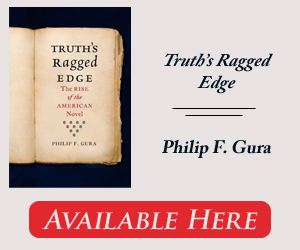Truth’s Ragged Edge: The Rise of the American Novel, By Philip F. Gura, Farrar, Straus and Giroux, 400 pp., $30
In its heyday in the mid-20th century, American literary history produced such monumental works as Richard Chase’s The American Novel and Its Tradition (1957), Alexander Cowie’s The Rise of the American Novel (1948), and F. O. Matthiessen’s powerfully argued American Renaissance (1941). The last declared the important writers of the 1850s to be Emerson, Thoreau, Hawthorne, Whitman, and Melville, omitting novels by women, and dominated American literary study for decades. Since the 1970s, however, critics and scholars have engaged in fierce disputes about the canon, replacing the authoritative single-volume study with essay collections, postmodern thematic compilations, and multivolume projects that now lie forgotten like huge fossils in the desert.
Philip Gura, a distinguished professor at the University of North Carolina–Chapel Hill who specializes in Puritan theology and the American transcendentalists, intends his book to revive the “dormant genre” of American literary history. Truth’s Ragged Edge (the title comes from Melville’s Billy Budd) covers the emergence of the American novel from 1789 to the 1870s. Gura provides a long-awaited new map of American fiction, including works by women, African Americans, and popular, working-class, and periodical writers. He gives biographical information about little-known writers, summarizes unfamiliar books, and explains changes in publishing, marketing, and reviewing that helped the novel to rise and allowed new groups of novelists to emerge.
The earliest American novels were mainly religious and didactic, but from the beginning American novelists also found their plots in violent crimes and sex scandals reported in the newspapers and magazines. Alongside Susanna Rowson’s bestselling weepie Charlotte Temple (1791), Gura places Charles Brockden Brown’s Wieland (1798), involving illegitimacy, seduction, incest, and suicide. He argues that in the 1820s, the woman-centered historical fiction of Catharine Sedgwick, the gothic fantasies of William Gilmore Simms, and the interracial themes and sexual frankness of the outlier John Neal did more to advance the novel’s form than James Fenimore Cooper.
In the watershed decade of the 1850s, Gura writes, bestselling women writers like Susan Warner, Fanny Fern, and Caroline Chesebro created “new ways of presenting character and selfhood” and tempted other writers to transgress boundaries of gender and race. The most important of these writers, Harriet Beecher Stowe, “brought the sentimental novel into conversation with fugitive slave narratives” and “made possible fully realized novels by African Americans, the first of which were greatly affected by Stowe’s characters and plot.”
Gura also praises forgotten novels that brought new subjects, techniques, psychologies, and points of view to American fiction before 1870, including George Lippard’s “morally impassioned” The Quaker City (1844); Donald G. Mitchell’s Reveries of a Bachelor (1850), an early effort at stream of consciousness; Alice Cary’s “dark, suggestive tale of adultery,” Hagar (1852); Frank J. Webb’s saga of a black Philadelphia family, The Garies and Their Friends (1857); Lillie Devereux Blake’s gothic Southwold (1859); Rebecca Harding Davis’s novel of “social awareness and concern,” Margret Howth: A Story of To-Day (1862); preacher Henry Beecher’s tale of “faith-based love,” Norwood (1867); and Elizabeth Stuart Phelps’s narrative of a female genius, The Story of Avis (1867).

But Gura’s enthusiasm for neglected novels does not explain why changing the American literary canon is so important. At the end of his book, Gura sums up his thesis as the “shift from a theology of intellect to one of feeling” and the shift from individuality and self-reliance to novels that attempt to take on the full American social experience. “Making the mind aware of itself is not enough,” he concludes. “It must become aware of and concerned with others. Trying to encourage such awareness and commitment was the burden of American fiction in its first century. It remains ours.” While undeniable, his conclusion seems undramatic, even flat.
In a footnote, Gura quotes the 1993 prophecy of literary critic Nina Baym: “If critics ever permit the woman’s novel to join the main body of ‘American literature,’ then all our theories about American fiction … will have to be radically revised.” Twenty years on, Gura has joined woman’s fiction and African-American fiction to the main body of the American novel, but his surgery is bloodless and dry. Citing only reviews contemporaneous with the novels he discusses, he leaves out the passionate late-20th-century struggle to bring women and blacks into the literary tradition, overlooks what was at stake in the resistance to admitting them, and ignores the theories that have been revised by their inclusion. The story of that hard-fought battle is part of American literary history, too.

